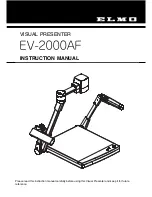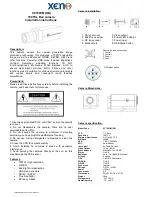
Installation Instructions
Installation precautions
Panasonic does not accept any responsibility for accident or damage during installation if procedure in this manual is not
followed.
To installation personnel
Read the “Installation Instructions” thoroughly and then perform the operation correctly and safely.
Also, always read the “Read this first!” (→ page 4) of this manual as they contain important information.
After the installation, give the “Installation Instructions” to the customer to save for future use.
Ensure that the installation work complies with
the technical standards governing electrical
equipment.
This unit is a stand-alone (desktop) device
that supports installation outdoors.
This unit is not designed to be used in vehicles.
If the unit will be subjected to extreme vibration, take measures to
reduce the vibration before use.
Use the unit with an installation where the unit
is suspended from an overhead surface or with
a stand-alone installation.
Do not use the unit on its side or tilted at an angle.
<NOTE>
•
Be absolutely sure to use the supplied mounting bolts (M8) for the
unit.
Do not use wood screws, nails, etc.
In the case of a concrete ceiling, secure the unit using anchor bolts
(for M8) or AY plug bolts (for M8).
Recommended clamping torque
M8: 11.76 N·m {120 k
g
f·cm}
• The withdrawal strength of the mounting location for each screw
must be at least 1764 N {180 k
g
f}.
•
Do not hold the camera head while undertaking the installation work.
Doing so may cause malfunctioning.
OK
NG
OK
NG
Desktop installation
Hanging installation
Concerning the installation location
Consult the dealer about the installation area and then select a
strong ceiling, floor, or other area for the installation area.
•
Mount the unit to a ceiling or floor that is strong enough (one made
of concrete).
• Mount the camera unit to a part of the main structure of the
building or a part that is sufficiently strong.
•
Do not mount the unit on a plaster board or a wooden section
because they are too weak. If the unit is unavoidably mounted on
such a section, the section shall be sufficiently reinforced.
Concerning waterproofing and dustproofing
When installed correctly, the unit complies with IP65 waterproof and
dustproof performance standards.
Be sure to perform wiring and other installation procedures
according to the instructions in this document.
Do not install or use the unit in the following
kinds of locations.
• Locations where a chemical agent is used such as a swimming
pool
•
Locations subject to moisture or oil smoke such as a kitchen
• Locations that have a specific environment that is subject to an
inflammable atmosphere or solvents
• Locations where radiation, X-ray, intense radio wave, or strong
magnetism is produced
• Locations where seawater will directly splash on the unit and
locations where corrosive gas is generated such as volcanic
regions and spa areas
• Locations where the temperature is not within the specified range
(→ page 53)
• Locations subject to vibrations, such as on vehicles or above
product lines (This unit is not designed to be used in vehicles.)
• Locations subject to sudden changes in temperature, such as near
the outdoor unit of an air conditioner (The inside of the front glass
may steam up or condensation may form on it.)
Concerning installation in a seashore area
•
Salt damage prevention is applied to this unit. However, it is not
completely anti-corrosive.
Therefore, consider a place for installation where direct splash of
seawater can be avoided.
•
Especially when installing this unit in a seashore area or a place
where a snow-melting agent is applied, and also where rainwater
is avoided, it is recommended to regularly clean and rinse off salt
with water.
• In case of installing this unit in a seashore area or a place where
a snow-melting agent is applied, regularly check the status of
equipment. (Replace the parts as required.)
•
Provide a basic structure, pole, etc. for installing the unit that are
highly resistant to salt.
Concerning sulfidation caused by rubber
products
Do not install the unit near any rubber products (such as gaskets
or rubber feet) that contain sulfur. Sulfur components in the rubber
product may cause the sulfidation corrosion of parts such as
electrical components and terminals, leading to malfunction.
Concerning the tightening of anchor bolts and
screws
• The anchor bolts and screws must be tightened with an
appropriate tightening torque according to the material and
strength of the installation area.
•
Do not use an impact driver.
Use of an impact driver may damage the screws.
•
When tightening an anchor bolt or screw, ensure it is straight.
After tightening the screws or anchor bolts, perform checks to
ensure that the tightening is sufficient enough so that there is no
movement or looseness.
What to avoid to ensure that the unit will
perform stably over a prolonged period
• Using the unit for a prolonged period in a location with high
temperature and humidity levels will cause its parts to deteriorate
and shorten its service life.
•
Ensure that a cooling unit or heating unit will not blow any air
directly toward the installation location.
6







































